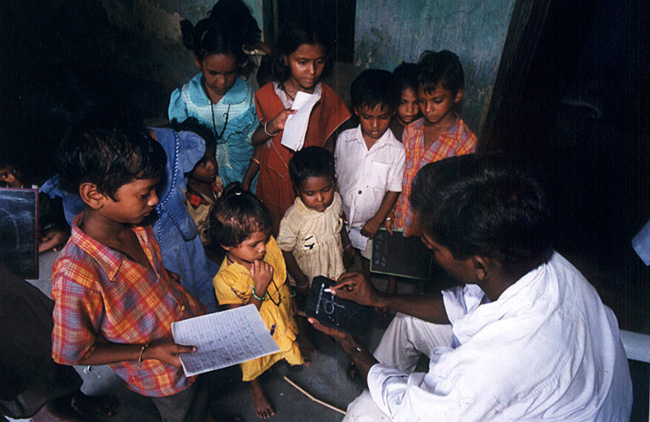For a change, development is a buzzword for Nitish kumar. Not that he thinks that only development will fetch him votes. He is quite clear that in a primordial society, votes are polled on caste and community lines. He has done everything possible to build a coalition of caste groups – he has become a rallying point for non-Yadav backward caste groups, he has won over the extreme backward castes by giving them reservations in jobs and panchayats, he has dented the stranglehold of Ram Vilas Paswan over the dalits by creating separate provisions for mahadalits, he has even won over a large section of Muslims by extending support to Pashmanda Muslim movement and sending its leader Ali Anwar to Rajya Sabha.
Lalu Yadav had got identified with the the creamy layer of the backward castes, Muslims and Dalits. By cobbling together the generally neglected extreme backward groups within them, Nitish Kumar has created a formidable social support base for electoral victory. The upper caste support via BJP is a bonus that makes him seem invincible.
Nitish kumar is serious about development, if not so much for getting votes as for creating a national, rather, international image. Not that Lalu did not hanker after attention worldwide. But Lalu tried to achieve it by exuding rustic charm. International television crew, not to talk of national TV camera persons, thronged his 1, Anne Marg residence round the year. Lalu kept them engaged delivering juicy one-liners while helping himself to generous doses of Khaini. When I met Nitish Kumar in 1993 for the first time along with Shivanand Tiwari, I remember his first comment: Laluji has put Bihar on the international map.
Nitish wants to hog the international limelight by good governance and has worked towards it. On the face of it, his achievements are spectacular.
If you travel through Bihar today and you have the experience of travelling the same distance 10 years ago, you will realize the difference. Good Roads and bridges have made travelling faster and comfortable. Improvement in law and order situation has made the life of common man relatively secure.
The biggest yardstick of inclusive development is the performance in sectors such as health and education. Health is an area where Nitish government seems to have performed reasonably well. The government has succeeded in instilling a sense of discipline among doctors and nurses to attend to their duties. The PHCs are functional. But the larger issue is the creation of bigger infrastructure. If a medical college-cum-hospital has just 50 beds, and 3000 patients are there at any point of time, hundreds would be destined to die because of lack of medical care. What is health roadmap? Is there a great vision? Nothing seems to be on record.

Bihar government’s achievement in the education sector is sadly disappointing. The higher education has been caught up in a turf war between the government and the governor and, as a result, the university education has gone to dogs. Even the primary education, which is the sole preserve of the state government, has become a messy affair because of a series of well-intentioned but wrong decisions. The gift of a bicycle to each school-going child was supposed to have swelled the ranks of enrolled children (that became a national hype), but, it has turned out to be a big hoax. By the government’s own admission, more than 10 lakh bogus admissions have come to light.
What is a more horrifying tale is the appointment of vagabonds as teachers -- some of them semi-literate and even illiterate -- on a variety of considerations. The consequences are disastrous: some rickshaw-wallahs and maids told me in Patna that they have put their girls in the government schools as they receive some freebies but they have put their sons in private schools as teachers there are more alert and ‘proper study takes place there’. If this is the situation in the state capital, you can think of the worse scenarios in the interiors of the state.
The biggest hype about the Nitish administration’s success story is the 10% growth rate in the last seven years. But as Ruchir Sharma writes in his seminal book “Breakout Nations”, India’s success story between 2005 and 2009 was due to a combination of international developments, not because of the UPA government’s grand policy formulation and its execution, as it was made out to be. If anything, India’s growth story was, despite, not due to, the Manmohan singh government. Once the world scenario turned, our UPA leaders have no place to hide.
The same could be said about the spectacular growth story of Bihar during this period. As Nawal Kishore Chaudhury, professor of economics at Patna University says: Nitish Government boasted of a 14% growth story in 2008-9. But now it has come down to 9.5%, which is a sharp fall. It has happened because the growth is based on a shallow foundation.
The fact is, the 10% development in Bihar is not driven by the growth in industry and agriculture but the service sector. As a corollary, the huge financial assistance from the Centre has led to massive increase of outlay in construction sector. From 6.7% of GDP in 2005, construction’s share has risen to 13,5 in FY12. On the other hand, manufacturing share has fallen from 6.5% in FY 94 to 4.9% in FY12. As Dr N K Jha, a noted economist based in Patna says, not even a needle factory has come up in the last seven years, though N K Singh-brokered photo-opportunity of leadings industrialists of India with Bihar’s strong man has been making headlines over these years.
The data on agricultural growth is rather fuzzy. Even though the government claims that the agricultural growth rate has turned to positive from negative (as it was in pre-Nitish era), the larger question is not of production maximization but of income maximization of farmers. Bihar is already a food-crop-surplus state. Ironically, that has led to the impoverishment of the farmers as the procurement is not taking place on a large scale and the food-grains are rotting due to adverse demand and supply situation. Has the Bihar government any grand vision to protect the farmers who constitute 70 % of Bihar’s population? There is, alas, nothing on record, again.
Overall, Nitish has turned out to be a better politician than Lalu – for the state of Bihar. But he has not shown signs of being a great visionary. A great leader should encourage honest and capable people in key positions, especially positions that handle thousands of crores of public money. But dynamic officers like Manoj Srivastava are made to languish in defunct planning boards because they would not sign on dotted line. Police officers like Manoje Nath are made to pay the price for being honest. Nath was appointed DG (Vigilance) at Bihar State Electricity Board (supposed to be a shunting post). But true to his calling, Nath did not sit quiet; he collected evidence of huge illegal benefits bestowed on big and influential power consumers and established the conspiracy of the BSEB chairman, Swapan Mukherjee (who had been pitchforked from a public relations officer of BSEB to the position of Chairman by the Nitish government) that resulted in Rs 100 crore loss to the state exchequer. As per law, he filed a case under the Prevention of Corruption Act . The Nitish government was furious at Nath’s audacity and transferred him out and started departmental proceedings against him. The BSEB chairman remained firmly entrenched and the case was quietly buried.
There are lots of such instances you get to know in private conversations with bureaucrats, politicians and journalists but you do not get to see them reported in the media. The reason is clear. As a senior journalist with a leading national daily says: “If Nitish Kumar is the ex-officio editor-in-chief of all mainstream newspapers and TV channels in Bihar, then how can you expect anti-Nitish stories in them?”
Previous page
This article is also published in Hard News.
* Director, Jagran Inst. of Mass Comm & Former resident editor , Hindustan Times, Patna
|


